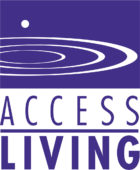Disability + Dance
Editor’s Note: Alana Wallace, founder of Chicago’s first diverse-abilities dance company, will participate in a panel on inclusive dance as part of CounterBalance 2020. You can read her story below. Counterbalance takes place virtually from October 7 through October 11. Access Living, in conjunction with Momenta Bodies of Work, and Studiothread will be hosting a variety of workshops, panels, dances, and more. To learn more about online integrated dance events and to register for CounterBalance, click here.
No one could have told me 25 years ago that I would have pursued a career in dance. I thought, “Dance for someone who uses a wheelchair? You’ve got to be kidding!” I must admit, as a professional actor and vocalist, the inclusion of dance into my work was a hard sell initially. Could artists with physical disabilities legitimately compete, or even be taken seriously in the arena of dance?
However, when I witnessed my first physically integrated dance performance by Cleveland’s Dancing Wheels, I was wowed. What thrilled me most was that their dancers who used wheelchairs were equal participants. They blew me away! I had to explore this new genre. After studying with Dancing Wheels and other professional dancers, I was inspired to form my own “diverse-abilities” dance company, Dance>Detour – the first of its kind in the Chicago area.
I approach dance from an artistic standpoint rather than a therapeutic one, but I must admit the healing benefits of dance are very apparent. Dance is a great way to alleviate stress, improve flexibility, burn calories, cultivate social and cultural interactions, and individually and collectively promote wellness and well-being. As a post-polio survivor, I feel dance has helped me to ward off secondary health problems.
Dance changed my life! I embraced my disability and my body in a way that I never had before. Integrated dance taught me that all movement is valid. For that reason, Dance>Detour adopted the motto, “Everyone Can Dance.” Members of our company ranged from 18 – 60+ years of age. We didn’t apply traditional dance stereotypes and restrictions regarding age, body type, uniform movement or range of ability. Sharing our artistic vision and a commitment to work hard were our only requirements.
I have found that my wheelchair is a beautiful accessory that allows me the freedom to express myself through movement in ways I never believed possible. For me, it is very much like the smooth gliding movements of an ice dancer – movements that cannot be duplicated on two feet. Dancers with disabilities combine imagination, exploration, and acquired technique to create movement that is so distinct and specific to each individuals movement potential.
What I do is bigger than just dancing. It is about LIFE! It’s about demonstrating that inclusion and diversity can apply not only to our art, but also to everything we do. I have overcome mental and physical challenges by first embracing them and then finding ways to turn lemons into lemonade. As dancers, we can broaden our growth if we challenge the established concepts of what dance IS and WHO can be involved.
